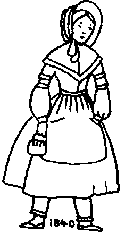
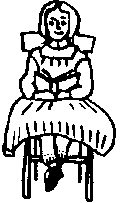
Return to my Societe Pages index
Return to the St Aubin index
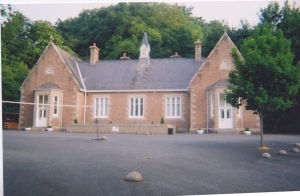
|
|
|
In St. Aubin the poor children used to have no chance of going to school. They had to start work at a very young age, and they could not read nor write. Most of them could not even speak English, as Jersey-French was still their main language. So, sometime in the l840s, a good lady called Mrs. Queripel decided to help. She started a small Dame School for infants in her living room. She lived halfway up Market Hill, in a plain granite house, which has now been rebuilt as Porthole Cottage Hotel.
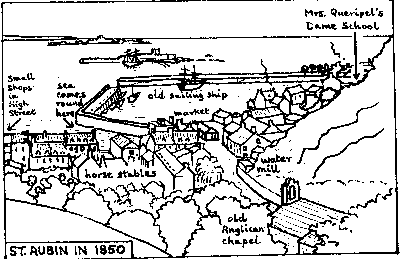
St. Aubin looked rather different in those days. At the bottom of the hill were the two long buildings of the busy market. Just around the corner was the wheel of the old water-mill, used for grinding corn to make flour. The ladies went shopping wearing neat bonnets and long wide dresses called crinolines. Horses and carriages went up the roads instead of cars, and. the harbour was quiet and almost empty of boats
From 1850 some of the leading families of St. Aubin decided to help Mrs. Queripel. Their leader was the Rev. Samuel King, the new minister of the Anglican chapel on the hill. He was much loved by his people and was a very clever man, an astronomer who spent hours studying the stars at night. Near the harbour he built his family home, the big square house called. Cardington Lodge. Mrs. King started -work-parties with the other ladies to raise money for the school
Her niece. Miss Scott, had a very good. idea. She collected many different kinds of seaweed from the beach near their house. Then she pressed them carefully and mounted them in albums, to be sold in aid of the school. Other ladies helped her, especially her friend, Julia Marett of La Haule Manor.
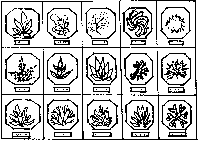
Some of these albums have been kept for over a hundred years, and yet the seaweeds are still pretty and full of colour. Some ladies managed to name 250 different kinds of seaweed. They presented their most beautiful book to Queen Victoria, who sent back a generous gift of money for the school.
Mrs. Queripel's daughter, Catherine, wanted to help in the school, so the ladies paid for her to be given some training as a teacher. With her help the school became larger, and began to take older children as well as infants. So they had to use their upstairs rooms for the Upper School.
One day in 1839 the children were very excited. Queen Victoria was paying a surprise visit to St. Aubin while her Royal Yacht was moored out in the bay. Everyone -was so surprised to see her land at the harbour that they just stood and stared. The Centenier had to remind them to wave and shout "Hurrah!" And one old lady could not believe it really was the Queen because she was not wearing her gold crown!
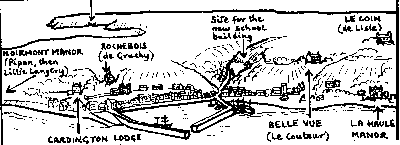
For many years the Le Couteur family took a special interest in helping the school. They lived in a big house called Belle Vue, high on the hill behind the Anglican chapel. The grandfather, a famous general, had died some years before, and his elderly widow, Mary, had helped Mrs. Queripel start her school in the l840s. The father of the house, Sir John Le Couteur, became one of the most important men in Jersey, as a soldier and as A.D.C. to Queen Victoria (a kind of special advisor)
He decided to adopt the school as a thanks offering for being kept safe in his battles. It seemed wise to look for a bigger house for the school, so his family helped to run bazaars in their beautiful large garden at Belle Vue.
Sir John's eldest daughter. Harriet, never married and spent much of her life helping the people of St. Aubin. She loved the children and visited the school regularly until she was an old lady. When she died the children were very sad and collected bunches of violets to place on her coffin.
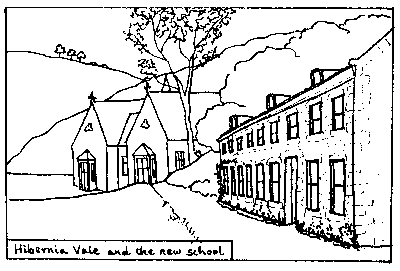
By the 1860's -the school had over a hundred pupils. So the St. Aubin families decided to look for a house with a very big garden, to give plenty of room for building anew school. In 1865 they found just what they needed. Hibernia Vale was a long granite house a little way up the valley. It had a wide garden stretching down to the new road and the stream. So they bought the house and land, and found two new teachers to be in charge of the school.
Mr. John Paul became the Master for the boys, and his wife, Emma, was the Mistress for the girls.
One writer says that the school soon grew to over two hundred children, We wonder how they all fitted into Hibernia Vale! It became known as St. Brelade's School because it served the whole parish.
In 1869, there was great excitement for the opening of the railway line from St. Helier to St. Aubin. At Noirmont Manor there was a huge party for 3,000 people! Guests included Dean Le Breton, who brought his young daughter, Lillie, later to become the famous actress, Lillie Langtry. She loved this Manor very much and lived there for a short while after her marriage in 1874. She did not stay long enough to become interested in the school. But the children may have noticed this beautiful young woman fishing from the harbour with the old fisherman, George Marett.
Three trustees were chosen to plan the new school. They were Sir John Le Couteur, Philip Marett of La Haule Manor, and the Rector of St. Brelade, the Rev. Edouard Falle. But the Rector was an old man and not very well, so he asked his Curate, the Rev. John Hammond, to be in charge of the building plans. All the families worked hard to raise more money. Bazaars were held at Belle Vue and La Haule Manor, and they then held a Grand Fete somewhere rather unusual: they borrowed the big Railway Terminus. We hope they were not disturbed by the trains!
At last they collected enough money and could start to build. June 5th, 1878, was a very exciting day. Everyone gathered in the garden to watch the Bishop of Winchester lay the foundation stone. After that, the builders worked fast, and by 1880 the children could move into their beautiful new school.
|
|
|